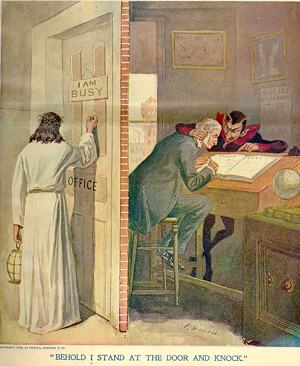History 2710 MacKay
The Gilded Age
 The January 11, 1896 cover of The Ram's Horn, a
magazine devoted to the "social gospel." ( The Ram's
Horn was published in Chicago, Illinois during the
1890s and the early years of the twentieth century by Frederick L. Chapman &
Company.
Frank Beard was its principal illustrator.)
The January 11, 1896 cover of The Ram's Horn, a
magazine devoted to the "social gospel." ( The Ram's
Horn was published in Chicago, Illinois during the
1890s and the early years of the twentieth century by Frederick L. Chapman &
Company.
Frank Beard was its principal illustrator.)
What do you already know about the Gilded Age?
Take
the sample AP quiz on the Gilded Age.
Mark Twain called the late nineteenth-century the "Gilded Age." In the
popular view, the late nineteenth century was a period of greed and guile, when
rapacious robber barons, unscrupulous speculators, and corporate buccaneers
engaged in shady business practices and vulgar displays of wealth. It is easy to
caricature the Gilded Age as an era of corruption, scandal-plagued politics,
conspicuous consumption, and unfettered capitalism. But it is more useful to
think of this period as modern America's formative era, when the rules of modern
politics and business practice were just beginning to be written.
While the rich wore diamonds, many wore rags. In 1890, 11 million of the
nation's 12 million families earned less than $1200 per year; of this group, the
average annual income was $380, well below the poverty line. Rural Americans and
new immigrants crowded into urban areas. Tenements spread across city
landscapes, teeming with crime and filth. Americans had sewing machines,
phonographs, skyscrapers, and even electric lights, yet most people labored in
the shadow of poverty.
Between 1870 and 1900 the United States became an industrialized economy--the
leading industrial nation in the world. And wealth became markedly more
concentrated. The share of national
wealth held by the richest one percent of households peaked at around 45 percent
sometime around 1900
The gap between the rich and the poor during the late 19th
century can be expressed in:
| Monthly budget of a laborer, his wife, and
one child in 1891; his income is $23.67 |
Monthly budget of a married bank accountant
with no children 1892; his income is about $66.50 |
| Taxes and insurance |
$3.32 |
Taxes and insurance |
$7.11 |
| Utilities |
$2.94 |
Utilities |
$4.99 |
| Transportation |
$.08 |
Transportation |
$1.71 |
| all else= total |
$28.01 |
all else = total |
$43.17 |
Source: Zunz, The Changing Face of Inequality, 1982
LABOR FORCE
DISTRIBUTION, 1879-1900; U.S. Census
|
| WORKING CLASS 53.3%
FARMER 32.0% |
WORKING CLASS 52.3%
FARMER 32.1% |
WORKING CLASS 54.3%
FARMER 26.3% |
WORKING CLASS 53.2%
FARMER 25.3% |
Source: U.S. Bureau of the Census
![[rockefeller.jpg]](http://1.bp.blogspot.com/_nsmEr2CaDSE/R8FTW46SUcI/AAAAAAAAADY/5oI8G0O5cFg/s1600/rockefeller.jpg)
A cartoon about Rockefeller's excessive influence in Washington, D.C.
Corporation: One of the three basic forms of
business organization (the other two are proprietorship and partnership). A corporation is a business
established through ownership shares (termed corporate stock). Since Supreme
Court rulings in the 1870s, A corporation is considered a distinct legal person, that can be sued, forced to pay taxes,
etc., just like a human person. Unlike proprietorships and partnerships businesses, a corporation business
exists separately from its owners. As such, the owners have what lawyer-types term limited liability. Owners
can not be held personally responsible for corporate debts. The owners can only lose the value of their
ownership shares, but no more.
Socialism develops in the 19th century as a
critique of capitalism -advocates a system of collective or government ownership and management of
the means of production and distribution of goods. Because of the collective nature of socialism, it is to be contrasted to the doctrine of
the sanctity of private property that characterizes capitalism. Where capitalism stresses competition and profit, socialism calls for
cooperation and social service. In a broader sense, the term socialism is often used loosely to describe economic theories
ranging from those that hold that only certain public utilities and natural resources should be owned by the state to those holding
that the state should assume responsibility for all economic planning and direction.
What do you already know about the Gilded Age?
Take
the sample AP quiz on the Gilded Age.
Readings:
Recommended Reading:
- Don't Know Much: 264 - 276.
-
Lecture 04, The Gilded Age and the Politics of Corruption
-
Lecture 05. Businessmen and "That Creature" the Corporation
-
Lecture 06, The Social Philosophy of American Businessmen
Discussion Topics: Why did the new corporations and the
robber barons gave rise to economic disparities. Why do you think some observers
are calling our own times "A New Gilded Age"? How does Riis" work confirm Mark Twain's
characterization of the post Civil War period as a "Gilded Age."
Project #3: Chose one:
- Take a virtual
Tour of a New
York Tenement. Report your reactions.
- Read an essay by economist Brad Delong on "The
Robber Barons." How does this essay help answer the question which
is important for us today: At what level does corruption become
intolerable and undermine the legitimacy of democracy?
 The January 11, 1896 cover of The Ram's Horn, a
magazine devoted to the "social gospel." ( The Ram's
Horn was published in Chicago, Illinois during the
1890s and the early years of the twentieth century by Frederick L. Chapman &
Company.
Frank Beard was its principal illustrator.)
The January 11, 1896 cover of The Ram's Horn, a
magazine devoted to the "social gospel." ( The Ram's
Horn was published in Chicago, Illinois during the
1890s and the early years of the twentieth century by Frederick L. Chapman &
Company.
Frank Beard was its principal illustrator.)![[rockefeller.jpg]](http://1.bp.blogspot.com/_nsmEr2CaDSE/R8FTW46SUcI/AAAAAAAAADY/5oI8G0O5cFg/s1600/rockefeller.jpg)